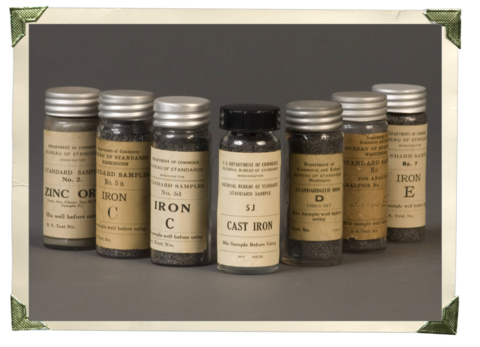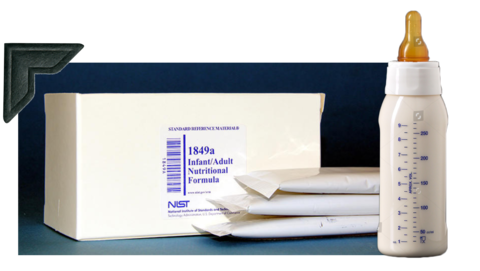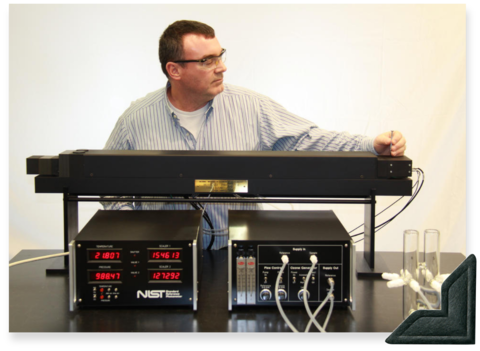Standard Reference Materials
In NIST’s early years, railroad trains were derailing in epic proportions. In the first decade of the 20th century, the U.S. government recorded approximately 4,000 derailments a year, with an average of about 13,000 people killed or injured annually.
One major cause was the fracturing of wheels. In 1905 the American Foundry Society approached the young agency with a solution: It had identified an alloy that would resist fracture. However, there was a still a problem: The foundries that would make the wheels lacked good sample materials that they could use as a reference in creating the alloys and maintaining quality control. So they asked NIST for help.

NIST then worked with the American Foundry Society to create uniform samples of iron whose chemical properties were well measured. In 1906, NIST released a series of four materials consisting of iron chips with slightly different chemical compositions. Foundries that made train wheels could compare NIST’s samples against theirs and create wheels of sufficient quality to reduce derailments. These iron samples were the precursor of NIST’s standard reference materials, which today number more than 1,300 different products.
“That really was the genesis of the program, and to this very day, it is exactly the service that we provide,” says Steve Choquette, the director of NIST’s Office of Reference Materials.
“I call it ‘truth in a bottle,’” he says. “We provide people with something that looks very much like what they're trying to measure, but they have the confidence that some of the world's best experts in our laboratories have analyzed the material. That not only gives them confidence in their measurements, but it also gives their customers a lot of confidence.”
Choquette immediately realized the importance of SRMs when he first arrived at NIST.
“When I came to NIST in the late 1980s, cholesterol measurements were horrific. You could go to your doctor in the early 80s, get a cholesterol measurement, and go down the hall to another doctor and get another measurement done. And you honestly could expect to see a variance of 100%. So, in one office, it might be 100 milligrams per deciliter, and the other could be 200. No one could make an informed decision based on that. And so NIST, at that time, put together a huge team to develop the top method for measuring cholesterol.”

“We would take plasma, measure the cholesterol in it, and produce that as an SRM. That gave our customers that much more confidence in what they're measuring,” Choquette says.
“We're not only world-leading at doing the measurements, but we’ve got some of the best instruments in the world and really some unique capabilities,” he says. “So, we're transferring that ability to our customers through this SRM, through this ‘truth in a bottle’ approach. That's what SRMs are really meant to do.”
Choquette says that there may be something even more important than the accurate values NIST provides for the various quantities in their SRMs.
“The other key thing that's really super important about all of these measurement services, SRMs in particular and calibration services as well, is not the number,” he says. “It's the uncertainty. That is really our value add. It's what's after the plus or minus, because that uncertainty helps our customers make informed decisions.”
“In the 1980s, that uncertainty would have been plus or minus 100, or something that is just absolutely grotesque,” he says. “Maybe that was the best we could do back then. But for the clinicians to make informed decisions about whether or not a measurement or a treatment protocol is actually working, you probably want the measurement to be accurate to 1% or 2%.”
NIST SRMs don’t just include numbers. Each one comes with a certificate, containing detailed information about the SRM and the methods used to measure it. SRM customers use this information heavily to help develop and verify the test methods that their laboratories use to measure their own products.

Philip Haselberger, senior research scientist at Abbott Laboratories, has used NIST’s SRMs on infant and adult nutritional formula for a number of nutritional formulas in his lab work.
"NIST SRMs have proven critical for validating, transferring, troubleshooting and assessing analytical test methods in laboratories with which we partner around the world,” says Haselberger, who works in Abbott’s Global Analytical and Food Safety unit. “This is because NIST's SRMs are extremely well characterized and provide reliable, certified values that serve as common reference points for all laboratories.”
In addition to SRMs, NIST produces standard reference instruments (SRIs). Sometimes a top-level laboratory, for example a national laboratory in a smaller country, needs to make the best possible measurements it can. If NIST simply calibrates that lab’s instrument, the calibration process inevitably adds some uncertainty to the measurements. So in some cases, NIST will build instruments for those labs, at a price that reflects the cost of producing them.
“If we build the instrument and compare it to ours, they get a much more accurate answer,” says Choquette.
For example, NIST-Boulder scientists produce world-leading instruments that provide extremely precise AC and DC voltage reference standards. So NIST will build voltage-measurement instruments for labs that wish to order them.
SRIs can be particularly useful when national laboratories compare their measurements with one another. Such “interlaboratory comparisons” help ensure that the world’s leading laboratories are producing measurements that are consistent with one another.
Another popular standard reference instrument is NIST’s ozone photometer, which was developed jointly with the Environmental Protection Agency (EPA) and accurately measures atmospheric ozone levels by detecting changes in ultraviolet (UV) light.
“It's an instrument that's used all over the world,” says Steve Choquette. With 42 having been built so far, they can be found in 24 labs spanning 19 countries. “So now, through our standard reference instruments, other labs are using the same kind of instrument.” And getting results that provide consistent levels of accuracy and precision all over the world.

